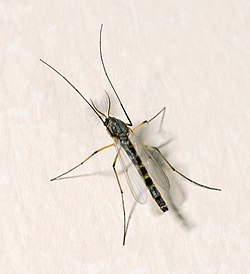| Chironomus plumosus | |
|---|---|
 | |
| Adult male | |
| Scientific classification | |
| Kingdom: | Animalia |
| Phylum: | Arthropoda |
| Class: | Insecta |
| Order: | Diptera |
| Family: | Chironomidae |
| Genus: | Chironomus |
| Species: | C. plumosus |
| Binomial name | |
| Chironomus plumosus | |
| Synonyms | |
| |
Chironomus plumosus, also known as the buzzer midge, is a species of nonbiting midge (Chironomidae) that occurs throughout areas in the Northern Hemisphere.